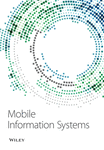Artificial Intelligence-Based Simulation Research on the Flipped Classroom Mode of Listening and Speaking Teaching for English Majors
Abstract
Information technology has become an important carrier for the implementation of flipped classrooms, giving full play to the role of modern education technology and transforming the traditional classroom teaching form into an important form in today’s education reform. This article mainly studies the simulation of the flipped classroom model of listening and speaking teaching for English majors based on artificial intelligence. A total of 31 English majors were selected for the experiment, including 7 boys and 24 girls. After obtaining the consent of school leaders and teachers, 16 weeks of experimental teaching were carried out in the class. The experimental subjects had not been exposed to the flipped classroom teaching mode before the start of the experiment, and they were willing to participate in this experiment. After the phased flipped classroom teaching mode was carried out in the experimental class, the teaching objects in the experimental class were selected in the form of interview questionnaires to understand students’ attitudes and acceptance of the flipped classroom teaching mode in English listening and speaking classes. Adjust and improve the poststage flipped classroom teaching model to provide reference. During the experiment, the control class adopted the multimedia courseware-assisted oral teaching method and, in the experimental class, flipped the classroom oral teaching mode. Teachers integrate resources when preparing lessons to design flip-flop classroom oral English teaching, and teachers guide students to use the internet to search for resources and preview independently. The average value of the English self-management learning ability of the students of this major was 27.48 points before the experiment started. After passing the experiment, the score increased to 38.90 points, and the average value increased significantly (t = −20.189, P < 0.01). A comparatively complete comparison of English listening and speaking teaching results was carried out. Before the implementation of the flipped classroom, the students’ average professional English score was 76.23 points, and the average score after the launch was 84.39 points. The overall average score increased by 8.16 points. With regard to students’ English learning scores, there has been some improvement. The results show that, through the implementation of flipped classrooms, students have exercised their ability to self-manage their learning and strengthened their ability to make learning plans, implement them, and reflect on the effectiveness of learning.
1. Introduction
Economic development and technological progress have made the combination of technology and teaching an unstoppable trend. Frontline teachers and scholars implement the most appropriate teaching methods to meet the needs of domestic students in science and technology teaching, and explore various teaching modes. Flipped classroom has reformed the tradition of previous teaching models and changed the roles of teachers and students through independent learning, research, participation experience, and practical application. Compared with the traditional teacher education curriculum, it brings the reform of the teaching mode through online and offline interactive learning modes, which meet the needs of the reform of the English listening and speaking teaching method. With the help of the development of information technology, the flipped classroom has subverted the traditional teaching link, and went the other way, perfectly presenting the student-oriented education concept. Flipped classroom has achieved good teaching results in practice teaching in some areas of the country. Artificial intelligence can be divided into three different types of systems: analytical, human-inspired, and humanized artificial intelligence. Analytical artificial intelligence has only features consistent with cognitive intelligence; it generates a cognitive representation of the world and uses learning based on past experience to provide information for future decisions. Human-inspired artificial intelligence contains elements of cognition and emotional intelligence; in addition to cognitive factors, it is necessary to understand human emotions and consider them in decision-making.
The new curriculum reform has made great changes in the content, form, ideas, and concepts of English listening and speaking teaching. With the continuous progress of the teaching reform, English listening and speaking teaching has made some progress and achievements in certain aspects, and has also exposed many problems. The practical significance of this article is that it can bring important practical experience to the development of flipped classroom teaching for English majors. With the help of the teaching practice of the flipped classroom in listening and speaking teaching for English majors, it carries out a comprehensive arrangement and correction to explore the design process of the flipped classroom in the English classroom, the setting of the teaching plan, and the implementation countermeasures. The traditional classroom teaching model is a teacher-centered, book-centered, and classroom-centered teaching model. The traditional classroom teaching mode often forms a situation where teachers are one-way indoctrinated and students passively accept it. It is not difficult to see that the defects of the traditional teaching mode are very obvious. The key is that the students as the cognitive subject are always in the whole teaching process. In the position of passively accepting knowledge, the initiative of students to learn is ignored or even suppressed. FCM refers to readjusting the time inside and outside the classroom and transferring the decision-making power of learning from teachers to students. Under this teaching model, students can focus on active project-based learning in the precious time in the classroom, jointly research and solve the challenges of localization or globalization and other real-world problems, so as to gain a deeper understanding. K12, a special term for education, is an abbreviation for preschool education to high school education, and is now commonly used to refer to basic education.
Artificial intelligence technology has a certain promotion effect on the flipped classroom teaching mode. Sergis et al. believe that the blended learning environment supported by the flipped classroom model (FCM) has been repeatedly investigated in research and practical environments, mainly in terms of cultivating students’ ability to recognize learning outcomes and overall motivation in the learning process. His work is based on the educational data and evidence of three different implementations of FCM action research in different K-12 subject areas, and reports on the consistent positive discovery model of the FCM-enhanced blended learning environment to improve the aforementioned students’ learning outcomes and abilities in terms of experience, and it has a special added value to underperforming students [1]. Kuldeep et al. believe that technological progress has brought great pressure to the younger generation. Educators must develop innovative educational methods to help this generation prepare for future challenges, because the training cycle is relatively short. Flipped classroom or inverted classroom is such an innovation, which can enable learners to develop critical thinking skills, and master the method of absorbing a large amount of information by allowing students to participate in an active learning process. Reading and understanding are carried out at home, and classroom time is used for higher-level learning, such as analysis, evaluation, and application of basic information. He aims to guide educators to apply the concept of flipped classroom in teaching equipment [2]. Jiang et al. examined the impact of using automatic speech recognition (ASR) technology on the oral complexity of flipped English as a foreign language (EFL) course. A total of 160 college students participated in the 14-week quasi-experiment. The experimental group (EG) and the control group (CG) adopt the flipped teaching method, but EG students need to use ASR technology for additional preclass tasks. In each unit, record the performance of all students in class tasks, and use this as a basis to code and calculate oral complexity indicators. He adopted a two-way intersubject and intrasubject repeated measurement design to investigate the influence of group factors, time factors, and group × time interaction effects. The results show that in terms of vocabulary complexity and syntactic complexity, the experimental group students are statistically better than the control group students [3]. Al-Mofti believes that for Iraqi English learners who use traditional teaching methods to learn English pronunciation, more effort is often required. Therefore, it is necessary to use new teaching methods, such as the flipped classroom model (FCM), to promote learning and improve performance. He uses mixed research methods to collect data in quasi-experimental analysis. Therefore, two tests were performed on the designated group to measure the effect of FCM before and after the intervention. In addition, he conducted questionnaire surveys and interviews with the experimental group students to collect their views on FCM. The study time is 15 weeks and is composed of 60 students from the English Department of the Art Department of Anbar University. The students are divided into an experimental group and a control group, with 30 people in each group. The results of the study show that there are significant statistical differences between the two groups, which is conducive to the better-performing experimental group [4]. Karatsiori et al. mainly study the peer online professional development methods of in-service English teachers. In the digital age, teacher education is constantly changing. The online collaborative professional development method using social media, digital platforms, and tools can become an interesting way to create a practical community. In the practical community, English teachers can participate in the generation and joint development of digital learning content, new concepts, and teaching models in a trust environment. The examples he selected will show how English teachers play the role of teacher coaches and actively involve other English teachers in technology integration in-depth topics, rather than providing independent courses on how to use technology. Flipped classroom teaching method will be combined with specific technologies to develop ICT skills and enrich teachers’ practice. The method he introduced can be used to provide further training and provide continuous support and guidance to hone and develop English language skills [5]. Xu et al. believe that due to the practicality of sports skills teaching, traditional physical education teaching methods can no longer meet this requirement. Therefore, a flipped classroom based on neural network technology came into being. It is not only possible to promote the modernization of sports, but also to ensure that it has a positive educational impact. He proposed a method of using particle swarm optimization neural network to predict college students’ sports performance to accurately predict sports performance and provide a reliable analysis basis for the formulation of physical education goals. He used neural networks in the model. Teachers always play the role of facilitator and assistant in the teaching process, which has realized the transformation of teachers and students’ self-positioning, allowing students to better play a leading role, and inspiring students’ interest in learning [6].
The flipped classroom under artificial intelligence is full of technological sense, which is of great help to the improvement of students’ interest. It can help students break the conventional teaching methods, and the classrooms presented are also colorful.
2. Methods and Experiments
2.1. Construction of the Teaching Mode
The basic steps of flipping the classroom are shown in Figure 1. Before class, students use the videos issued by teachers to carry out autonomous learning, so as to carry out targeted learning. Students in the classroom will discuss the problems encountered in autonomous learning with teachers and students in the classroom, and finally get the corresponding answers. Teachers specifically give evaluation and feedback on the results obtained by students. As for flipped classroom practice, it not only covers the classroom, the roles of teachers and students, learning and evaluation flipping but also covers the four characteristics different from traditional classroom teaching. Only by understanding and mastering these characteristics, teachers can better guide students and continuously improve students’ learning efficiency. In short, it is to replace the previous “teaching after learning” with “learning before teaching” so that students can use their previous experience in their spare time to deal with problems in learning, and then use class time, with the guidance and assistance of the teacher, to deal with the current unsolvable problems. If students have accumulated problems that cannot be solved by them through preclass learning, teachers will guide and answer them in class [7, 8]. Each step of the flipped classroom is very important. Before the class, we can prepare for the class in advance through some videos on the Internet, and then we learn that we can watch the videos independently by watching some learning videos. To be clear about your learning tasks and the exercises we need to carry out in class, after watching the video, we will discuss the content taught in the video. In this way, we can achieve the progress of our study.
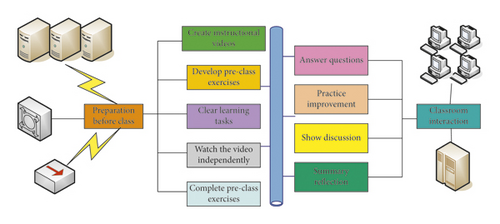
2.2. Artificial Intelligence
The framework of artificial intelligence English teaching is shown in Figure 2. The English expert system is mainly used to analyze the students’ mastery of knowledge points in a certain test. It has the characteristics of causality, logic, process, and structure. Therefore, the system adopts a method of mixed knowledge expression based on rules and frameworks. This can make full use of the advantages of these two kinds of knowledge expression, learn from each other, enhance knowledge expression ability, and improve reasoning efficiency [9]. In addition, learners in the AI English teaching system can gradually solve the problems they encounter in the English learning process through the guidance of the artificial intelligence English teaching system, and can even use relevant platforms and resources to solve a certain problem in the field. Through in-depth research and discussion, you can also independently choose the key points and difficulties of the course, learning methods, learning strategies, find a personalized English learning method that suits you, and improve your problem-solving ability and information technology operation ability [10].

2.3. Experimental Objects
Choose a certain class of English major for experiment. There are 31 students in this class, including 7 boys and 24 girls. There were 3 boys and 12 girls in the experimental group, and 4 boys and 12 girls in the control group. After obtaining the consent of school leaders and teachers, 16 weeks of experimental teaching will be carried out in this class. The experimental subjects had not been exposed to the flipped classroom teaching mode before the start of the experiment, and they were willing to participate in this experiment. The unification of the above conditions can better judge whether this experiment has a significant teaching effect on English listening and speaking teaching [20]. Fifty College English teachers were selected to conduct a questionnaire survey to understand the current situation and existing problems of College English teachers’ writing teaching design from five dimensions: College English teachers’ writing teaching design concept, the role of College English writing teachers, students’ participation, the comparison of teaching and learning time, and teaching effect. 50 questionnaires were distributed and 50 were recovered, and the effective rate was 100%. The respondents should be universal and representative in terms of gender, teaching age, educational background, and professional title.
2.4. Experimental Hypothesis
Flipped classroom can effectively promote the improvement of English autonomous learning ability, and has a beneficial impact on students’ self-management learning ability, psychology, and behavior. Flipped classroom can also effectively improve students’ English learning achievement. After the experiment, there is a positive correlation between their achievement and autonomous learning ability [21].
2.5. Experimental Tools
2.5.1. Questionnaire Survey
An effective questionnaire needs to have two major functions, that is, it can accurately and effectively pass the question to the surveyed person and make the surveyed person willing to answer. When measuring autonomous learning ability, self-declaration questionnaires are generally used, which have high authenticity and objectivity, and the final results are easy to quantify and formalize. The questionnaire can be used to understand the learning process of students, the ownership rate of mobile terminals and the use of network resources, analyze the current situation of English teaching and the characteristics of students and learning, and prepare for the development of flipped classroom teaching suitable for the personality characteristics and learning characteristics of college English majors [22]. The main content of the questionnaire is aimed at students’ and teachers’ attitudes towards flipped classrooms, and their expectations for this model. There is also what they feel they need to improve under the traditional teaching mode.
2.5.2. Interview Questionnaire
At the beginning of the experiment, some representative experimental subjects were selected, and in-depth interviews were adopted to understand the subjects’ views on English classroom teaching at the junior high school stage, and to understand their English learning conditions before enrollment. After the phased flipped classroom teaching mode teaching was carried out in the experimental class, the teaching objects in the experimental class were selected in the form of interview questionnaires to understand students’ attitudes and acceptance of the flipped classroom teaching mode in English listening and speaking classes. Adjust and improve the poststage flipped classroom teaching mode to provide reference [23]. The main content of the interview is what they think about the new teaching model, and how they gain under this model.
2.6. Experimental Process
During the experiment, the control class adopted the multimedia courseware-assisted oral teaching method, and in the experimental class, flipped the classroom oral teaching mode. Artificial intelligence (AI) is sometimes called machine intelligence, which is the intelligence displayed by machines, in contrast to the natural intelligence displayed by humans and animals. In layman’s terms, the term “artificial intelligence” is used to describe machines that imitate the “cognitive” functions associated with humans and other human thoughts, such as “learning” and “problem solving.” Teachers integrate resources when preparing lessons to design flip-flop classroom oral English teaching, and teachers guide students to use the Internet to search for resources and preview independently. In the classroom, through cooperative learning and group discussions, topical speeches and situational performances, the ability to use oral English is cultivated. Teachers encourage students to engage in interactive discussions and enhance their ability to use oral English. After the experiment, the students in the control class and the experimental class take the posttest exam. The posttest paper consists of three parts: the first part is self-introduction; the second part is topic speech; and the third part is question and answer. The test time is 6 minutes [24].
2.7. Data Collection
Before the experiment, the teacher issued 31 pretest questionnaires, and all 31 copies were returned, which means an effective rate of 100%; meanwhile, the class’s first monthly test scores are considered as the pretest data of English proficiency. After the 16-week experiment was completed, the teacher issued 31 posttest questionnaires, and all 3l copies were recovered, with an effective rate of 100%; the performance in the final exam of the entire class was collected as posttest data. Finally, 62 questionnaire information and two test scores were entered in SPSS20.0 [25].
3. Results
The survey and analysis results of teaching design concept are shown in Table 1. 50 teachers, accounting for 66.7% of the total, think that students’ acquisition of knowledge is more important than ability training in traditional teaching design; 47 teachers, accounting for 58.8% of the total, pay attention to the link of “teaching” in teaching design. Only 38 teachers, accounting for 47.5% of the total, believe that they can fully consider students’ learning situation and characteristics in teaching design. And, only 46 teachers, accounting for 56.8% of the total, believe that they pay attention to the concept of “student-centered” and “everything for each student” in teaching design. To sum up, in the traditional college English listening and speaking teaching design, the educational concept of “student-centered” and “everything for each student” has not been widely valued by teachers. Through a related survey of our teachers in a certain school, we found that many teachers have different teaching philosophies. The investigation and analysis of teaching design philosophies can allow us to better understand the ideas between teachers and them. We can use this to help students achieve the best learning situation.
| A | B | C | D | E | |
|---|---|---|---|---|---|
| Question 1: You think that knowledge transfer is more important than the development of students’ ability when making English listening and speaking teaching design | 26 | 24 | 12 | 7 | 6 |
| Question 2: You give full consideration to students’ learning situation and characteristics when designing English listening and speaking teaching | 25 | 13 | 7 | 15 | 20 |
| Question 3: You pay attention to the “teaching” link when designing English listening and speaking teaching | 31 | 16 | 12 | 15 | 6 |
| Question 4: You pay attention to the concept of “student-centered” and “all for each student” when designing English listening and speaking teaching | 20 | 26 | 12 | 10 | 13 |
- A: completely conforming; B: basically conforming; C: generally; D: basically nonconforming; E: completely nonconforming.
The results of the comparative investigation and analysis of teaching and learning time are shown in Figure 3. In traditional classroom teaching, “teaching” and “learning” seem to never be able to achieve harmony and unity. According to the results of survey data analysis, nearly 63% of teachers believe that they spend more time teaching knowledge in class than students studying; only fifty-three teachers, or 40.7%, think they can pay attention to the time comparison between teaching and learning; only 40 teachers, or 30.7%, will arrange students to conduct self-study before class; 97 teachers, or 74.6%, teach completely by means of explanation. Only 54 teachers, or 41.5%, are able to let students take the initiative to raise learning difficulties in the classroom.
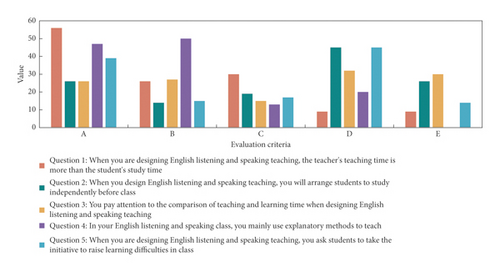
In order to further explore the specific impact of flipped classroom on students’ autonomous English learning ability, a paired sample t-test was performed on the pre- and posttest data of students’ autonomous learning ability. The overall analysis of the self-learning ability before and after testing is shown in Table 2. Before the experiment, the average value of the students’ autonomous learning ability was 82.9 points. After the experiment, the average value was 121.45 points. There is a significant difference in learning ability (t = −31.156, P < 0.01). In short, with the help of flipped classroom teaching, students’ English autonomous learning ability has been significantly improved, and the difference is significant (self-management learning ability t = −20.189, P < 0.01; autonomous learning psychology t = −21.503, P < 0.01; autonomous learning behavior t = −17.778, P < 0.01). The standard deviation of self-management learning ability before and after the experiment was reduced from 5.656 to 4.437, the standard deviation of self-learning psychology was reduced from 5.139 to 3.739, and the standard deviation of self-learning behavior was reduced from 4.863 to 6.988.
| Dimension content | Before and after | Number of people | Mean | Standard deviation | t | Sig |
|---|---|---|---|---|---|---|
| Self-management learning ability | Before test | 31 | 27.48 | 5.656 | −20.189 | 0.000 |
| After test | 31 | 38.90 | 4.437 | |||
| Self-learning psychology | Before test | 31 | 28.29 | 5.139 | −21.503 | 0.000 |
| After test | 31 | 39.58 | 3.793 | |||
| Autonomous learning behavior | Before test | 31 | 27.13 | 4.863 | −17.778 | 0.000 |
| After test | 31 | 42.97 | 6.988 | |||
The data in the table are the data obtained by the school conducting related experiments, and the data obtained by conducting this test before and after they conducted the related experiment. The difference analysis of self-learning management ability before and after the test is shown in Figure 4. The average score of English self-management learning ability of students in this major before the experiment was 27.48 points. After passing the experiment, the score increased to 38.90 points, and the average value increased significantly (t = −20.189, P < 0.01). Before the experiment, the average score of students making learning plans was 10.16 and after the experiment was 14.39, which was significantly improved (t = −12.672, P < 0.01). Before the experiment, the average score of students’ implementation plan was 8.97 and after the experiment it was 12.32. The average score of implementation plan was significantly improved (t = −12.880, P < 0.01). Before the experiment, the average score of students’ reflective learning effect was 8.35 and after the experiment it was 12.19. The average score of reflective learning effect was significantly improved (t = −14.611, P < 0.01).
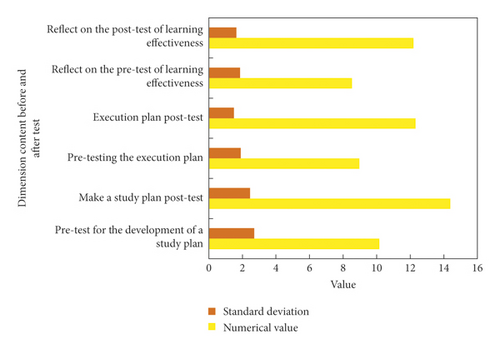
Figure 5 shows the analysis of the difference between pretest and posttest of self-learning psychology. Before the experiment, the average value of the English self-learning psychology of the students of this major was 28.29 points. After the experiment, the average value increased to 39.58 points, achieving a significant increase (t = −21.503, P < 0.01). Before the experiment, the average score of students’ mentality of undertaking learning responsibilities was 9.68, and after the experiment it was 13.77. It is divided into 11.71 and 16.19 points after the experiment. The average score of the execution plan has been significantly improved (t = −15.313, P < 0.01); before the experiment, the average score of the English learning strategy awareness is 6.90, and the score is 9.61 after the experiment, reflecting on learning. The effectiveness of the average score has been significantly improved (t = −14.990, P < 0.01).
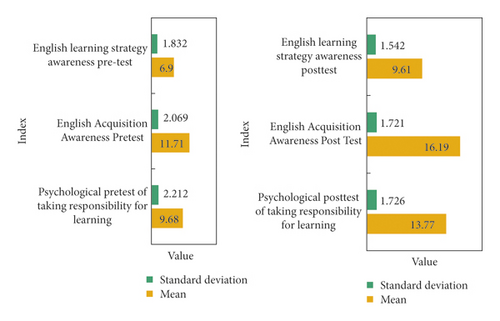
Table 3 shows the analysis of the difference between the pre- and posttest of autonomous learning behavior. Before the experiment, the average value of English autonomous learning behavior of the students of this major was 27.13. After passing the experiment, the average value increased to 42.97 points, achieving a significant increase (t = −17.778, P < 0.01). Before the experiment, the average score of the students with the behavior of actively taking on the responsibility of learning was 11.23, and the score was 17.87 after the experiment. The development of the learning plan was significantly improved (t = −6.773, P < 0.01); before the experiment, the students had effective use of management learning. The average score of strategic behavior is 8.00, and after the experiment it is 13.10; the average score of behaviors with effective use of management learning strategies has been significantly improved (t = −17.301, P < 0.01); before the experiment, the average score of students reflecting on learning effectiveness was 7.90, and it was 12.00 points after the experiment; the average score of reflective learning has been significantly improved (t = −16.305, P < 0.01).
| Dimension content | Before and after | Mean | Standard deviation | t |
|---|---|---|---|---|
| Actively assume the responsibility of learning | Before test | 11.23 | 2.513 | −6.773 |
| After test | 17.87 | 6.158 | ||
| Effective use of management learning strategies | Before test | 8.00 | 1.880 | −17.301 |
| After test | 13.10 | 2.135 | ||
| Behavior of other learning strategies | Before test | 7.90 | 1.423 | −16.305 |
| After test | 12.00 | 2.017 | ||
Figure 6 shows the comparison of English listening and speaking teaching scores before and after testing. Before the flipped classroom, the average score of students’ professional English was 76.23 points, and the average score after the development was 84.39 points. The overall average score increased by 8.16 points. There was a statistically significant difference before and after the experiment (t = −8.024, P < 0.01). This shows that during the period of the flipped classroom, student performance has improved significantly. In Figure 6, the standard error described by them has changed from 5.669 to 3.3.885, which shows that the learning effect of our students can be improved to a certain extent after the flipped classroom.
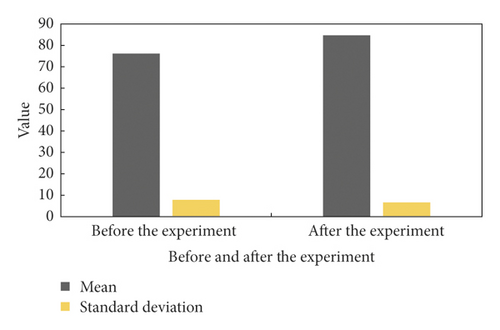
The experimental group and the control group are divided into half according to the grades of the students in the class. The grouping standard is that the two groups are close in number, and the average number between them is not much different. The statistics of the pretest results of the experimental class and the control class are shown in Table 4. The statistics of the posttest results of the experimental class and the control class are shown in Table 5. From the statistical results of the pretest group, it can be seen that the average scores of the control group and the experimental group are 16.75050 and 16.2250, respectively. The control group is slightly higher than the experimental group, but the results are not significantly different. There is no significant difference in the basics of English listening. In the English listening, pretest score statistics of the experimental class and the control class, sig = 0.508, is far greater than 0.05, and the variance is homogeneous. At the same time, P = 0.616, which is also far greater than 0.05. There is no significant difference between the two groups of samples, indicating that the experimental class is very close to the basic level of English listening in the control class and is comparable. From the posttest listening test scores of the experimental class and the control class, the average score of the control class is 11.4000, the average score of the experimental class is 14.3000, and the score of the experimental class is higher than that of the control class. From the independent sample t-test, it can be seen that the F value is 4.302, and the significance, Sig = 0.041, is less than 0.05. It can be considered that the difference in progress variance between the experimental group and the control group is significant, indicating that the flipped classroom teaching model can improve students’ English listening performance. It is more effective than traditional classroom teaching.
| Class | Average | Standard deviation | Mean standard error |
|---|---|---|---|
| Control class | 16.7500 | 4.22902 | 0.66867 |
| Experimental class | 16.2250 | 5.05603 | 0.66867 |
| Class | Average | Standard deviation | Mean standard error |
|---|---|---|---|
| Control class | 11.4000 | 4.79744 | 0.75854 |
| Experimental class | 14.3000 | 3.18812 | 0.50459 |
Figure 7 shows the survey results of students’ interest in learning English. About 20% of the two classes like English lessons very much and find English interesting, 32% of students are interested in English and like to take English lessons, and 30% of students are generally interested in English lessons; 10% of students hate English classes, and 10% of students hate English very much. It can be seen that students are generally not interested in English classes. This is inseparable from the reason that the teacher’s teaching is mediocre, which requires teachers to try new teaching methods to increase students’ interest in learning English.
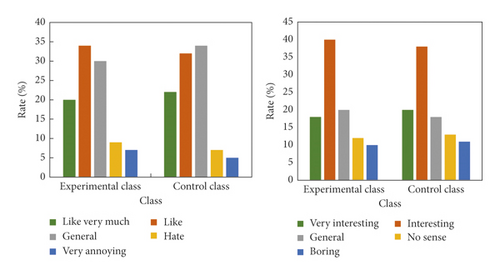
Figure 8 shows the survey results of students’ attitudes and situations towards self-study before and after class. In the experimental class, 27% and 23% of the students thought that pre-class preparation was very important, while 41% and 38% of the students in the control class thought that pre-class preparation was very important, about 24% of students think it is fair; 5% and 8% of students think that class prestudy is not important, and 3% and 6% of students think it is not important at all. It can be seen that most students pay more attention to the prelearning part, which requires teachers to also pay attention to cultivating students’ ability of self-study before class. At the same time, most students do not often study English after class, and the time after class is not used well.
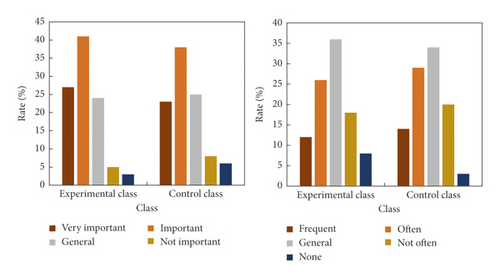
Figure 9 shows the independent sample t-test of the experimental class and the control class. The average score of the experimental class is 100.2000, the average score of the control class is 99.9857, the average score of the two classes is only a slight difference of 0.2143, the English scores of the two classes are not much different, and it can be judged that the levels of the two classes are very close. At the same time, the independent sample t-test found that t = 0.66, P = 0.948, and it is concluded that the P-value of significance level is greater than 0.05, indicating that there is not much difference in the English level of the two classes before the experiment. From a statistical point of view, the teaching experiment is feasible and reliable in these two classes.
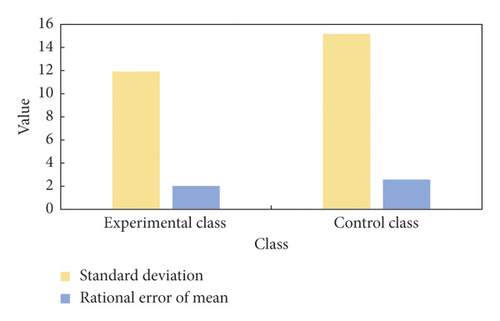
The survey of students’ attitudes towards classroom activities and their effects is shown in Figure 10. 29% and 27% of students, respectively, tend to learn in the traditional way of teaching by teachers. 23% of students said that group discussions should become a way of learning activities in the classroom. 17% of students prefer teacher-student question and answer; another 18% said that situational communication is beneficial to classroom learning. It can be seen that the communication between teachers and students and between students and students is an effective form of classroom teaching activities, and the initiative of students will be greatly improved. Therefore, teachers should give full play to the important role of organizers and coordinators in the teaching organization, so as to better realize the teaching purpose. 30% and 28% of the students in the two classes think that the effect of classroom communication and discussion is very good; 21% and 22% of the students think that the effect is relatively good; at the same time, about 10% of the students think that the effect is very poor. On the whole, classroom communication and discussion are an important way to effectively promote student learning.
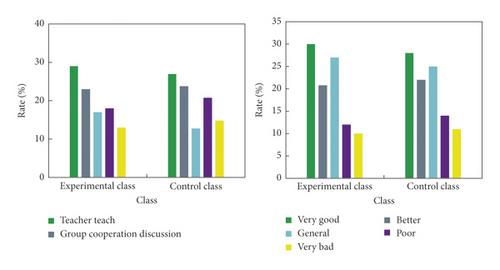
4. Discussion
Flipped classroom teaching concept coincides with the requirements of the new curriculum reform. Its scientific application in English teaching can optimize and improve the problems existing in English listening and speaking teaching. Whether flipping class is suitable for all courses is a question raised by everyone at present. Science courses have many knowledge points, many experiments, and strong operability. It is not easy to prepare learning materials before class. The characteristics of liberal arts courses are completely different from those of science. The knowledge of liberal arts courses is relatively interesting. It is relatively easy to make preclass learning materials and make learning materials to stimulate students’ interest in learning. In the flipped classroom, under the guidance of teaching objectives, we should use appropriate and effective tools and ways to comprehensively evaluate students’ knowledge, ability, emotion, attitude, and values. Therefore, the evaluation of flipped classroom needs the joint participation of teachers and students, and adopts an evaluation system based on process evaluation and supplemented by summative evaluation. The joint participation of teachers and students can ensure that students can complete the preclass study plan preview in time after class, and actively participate in discussion and speech in class.
After students have learned the autonomous learning materials, they should record the gains and questions in the learning materials. At the same time, students should complete targeted exercises before class, that is, the self-test card made by teachers, so as to consolidate the self-study content and find the difficulties of students through testing. Students grasp the process of self-study according to their own situation. Carefully complete the independent learning of learning materials according to their own learning speed, think about, and take notes on the doubts encountered in the materials, and record their own gains in order to share and communicate with their peers. After preclass self-study and group discussion, individuals should show themselves and the results achieved in group discussion in class. The display content mainly includes the problems and solutions encountered in the learning of self-study materials and the completion of self-test card, the gains in the process of group discussion, and accept the questions of other group students. Students are required to complete the content of the pass (trial exercise) within the specified time, complete the test in the form of group inspection and teacher supervision, and finally complete the explanation of the exercises on the pass through group discussion and teacher comments. Finally, it can solidify the knowledge of this course.
Before the implementation of the flipped classroom teaching mode, the English learning progress of the students in the experimental class was relatively slow. For this, the teachers deleted many knowledge points in the teaching process, the content of students’ English knowledge learning was very lackluster, and the learning method was relatively simple. From the questionnaire survey, it is found that most people believe that the main content of English learning is memorizing words. After practicing the flipped classroom teaching mode, students learn the basic knowledge at home and make effective use of extracurricular learning time, which not only saves a lot of time for the classroom but also enables students to carry out deeper English learning exercise. Teachers can provide targeted teaching strategies according to students’ self-study, make full use of classroom time, improve teaching efficiency, and optimize classroom teaching. In the course of the experiment, we can find that with the help of the flipped classroom, students’ academic performance will be improved to a certain extent. This can help students improve their learning efficiency, and to a certain extent, they can also help students increase their interest in learning.
Flipped classroom is an important organizational form of MOOC. MOOC provides students with a platform for self-learning and improvement. Flipped classroom, micro class, and MOOC are interlinked and interrelated to a certain extent. They all need the support of network information platform, through video reengineering education and personalized learning innovation. Autonomous learning runs through the whole flipped classroom. Before class, students should not only learn the learning materials prepared by teachers but also use Internet and other means to consult relevant materials, which is a self-guidance process [26, 27]. In class, students should communicate with their classmates and teachers according to the problems arising from preclass learning and classroom discussion, and actively seek answers to the problems in the communication. This is a self-strengthening process. Whether before class, in class, or after class, it is a process of students’ self-monitoring. Large-scale open online courses, or MOOCs, are a newly emerging online course development model. In 2012, top universities in the United States successively set up online learning platforms to provide students with the possibility of systematic learning. It has the characteristics of diversified tool resources, easy to use, and wide audience, so that everyone can obtain free resources from famous universities, and they can learn anywhere and with any equipment.
In the preclass learning stage, make some hard requirements as a standard for learning consideration, such as having preclass learning notes, carefully completing preclass learning materials, etc. The organization of classroom activities has to be improved. The main problems in classroom organization activities are as follows: on the one hand, students are not very positive in discussion. On the other hand, students cannot take the initiative to speak in the achievement sharing stage. Create scenarios and select exploratory topics for group discussion. In the process of classroom organization, we cannot simply give students a topic and ask students to discuss it by themselves. Instead, we should select inquiry topics, create the context of inquiry learning, and conduct collaborative overall inquiry in groups. This requires teachers to summarize the questions of inquiry value according to the teaching content and the questions raised by students in preclass learning.
Students choose topics of interest according to their own characteristics. The team leader responsibility system is adopted, that is, the discussion of each group is organized by the team leader. Each group shall elect a group leader and clarify the responsibilities of the group leader. The group leader shall cooperate with the teacher to complete the classroom interaction, supervise the group members to participate in the discussion, and select the group representative to speak. Teachers can further clarify the responsibilities of group leaders, cultivate the ability of group leaders to organize and manage, and strengthen and standardize the construction of groups. Make certain mandatory requirements for students in the independent speech stage, such as at least 2 representatives in each group to speak during this learning process. Clarify the content, form, and key points of the group report. Give timely encouragement to students’ progress through language or body movements.
In the traditional college English listening and speaking teaching design, for the teaching concepts of “student-centered” and “everything for each student”, teachers do not consider enough in teaching design, which eventually leads to insufficient learning situation analysis, and the formulation of teaching objectives is not fully formulated according to the specific learning situation of the teaching class, resulting in the lack of pertinence of teaching and ultimately affecting the teaching effect. In the traditional teaching design, most teachers impart new knowledge through teaching and play the role of knowledge porter. Under the orientation of such teaching design, teachers only teach them “fish” rather than “fishing.” In fact, the truly meaningful listening and speaking class should be that teachers guide students to actively explore, encourage students to be diligent in writing and try, and master the key points of knowledge in the actual combat of listening and speaking, so as to apply what they have learned and play the role of knowledge guide. In the traditional teaching design, teachers are completely limited by the teaching time and cannot design too many classroom activities. In addition, students are bound by the pressure of examination for a long time, and more teachers tend to adopt traditional teaching. They do not talk about what to test and what not to test. They do not need students to express their personal opinions but only need to remember the knowledge points of examination.
Flipped classroom model can bring more time for teachers and students to carry out classroom interaction, which will be conducive to the personalized development of students. Teachers have also successfully separated from the identity of the main body of the classroom and become tutors for students’ learning. In this way, the teaching content is stored by means of video, and scholars can give special review according to their own learning situation, so as to ensure that all students can achieve development. Simple explanation and constructivist learning concept have been effectively combined under this mode. This also presents the flipped classroom to the world, which is the crystallization of the wisdom of educators and a comprehensive investigation of the flipped classroom. Before teaching, students not only need to learn the learning materials provided by teachers but also need to find the corresponding materials by means of networks. This is the process of self-guidance: in the classroom, students should specially communicate with teachers and students on the questions based on the materials they have learned and prepared before, so as to actively obtain the answers to the questions. This is the process of self-strengthening. Whether before class, in class, or after class, it is the process of self-monitoring for students.
English teaching must adapt to the law of students’ cognitive development. The former stage is the main basis of the latter stage. This provides a solid foundation for the application of flipped classroom in listening and speaking teaching for English majors. Assimilation means that students carry out autonomous learning with the help of teaching videos or relevant materials. Adaptation is to carry out discussion and communication in the classroom and give different suggestions. Balance is the reflection of students in their spare time. This study also confirms that there is a very significant correlation between students’ English learning achievement and autonomous learning ability. The experimental results show that there is an obvious positive correlation between students’ posttest English academic achievement and posttest autonomous learning ability, which can also confirm that there is a close relationship between their English academic achievement and their autonomous learning ability.
5. Conclusions
Flipped classroom is a new teaching model that has been introduced into China after receiving a lot of praise in foreign countries. In terms of improving self-management learning ability, the flipped classroom teaching method enables students to make learning plans, implement plans, and effectively reflect on the effectiveness of learning. Therefore, through the implementation of flipped classrooms, students’ ability to self-manage their learning has been exercised, and students’ ability to make learning plans, implement plans, and reflect on the effectiveness of learning has been strengthened. In terms of improving the self-learning psychology, flipped classrooms have actively promoted students’ psychology of taking on learning responsibilities, especially in terms of English learning awareness, and it also has a certain role in promoting the awareness of English learning strategies. According to the questionnaire survey of students on the design and evaluation of flipped classrooms, although a small number of students are temporarily unable to adapt to the flipped classroom teaching mode, most students still like to use flipped classrooms for English listening and speaking teaching, and hope that teachers can continue to use them. In this mode of teaching, students’ acceptance of the flipped classroom teaching mode is still relatively high. When conducting experiments, the steps and processes of the experiment are relatively complete, and the results obtained are also relatively accurate. However, in our lives, there are still certain shortcomings in the experiment, that is, the selection of experimental subjects is too few, and the results are more accurate. The data obtained are relatively small, and the convincing power is not so great, but it is aimed at some technical problems, such as some children who are not used to the video light, which can easily cause sleep, and certain solutions need to be solved. In the future research life, we will strengthen the better enhancement of various technologies.
Conflicts of Interest
The authors declare no conflicts of interest.
Open Research
Data Availability
No data were used to support this study.



